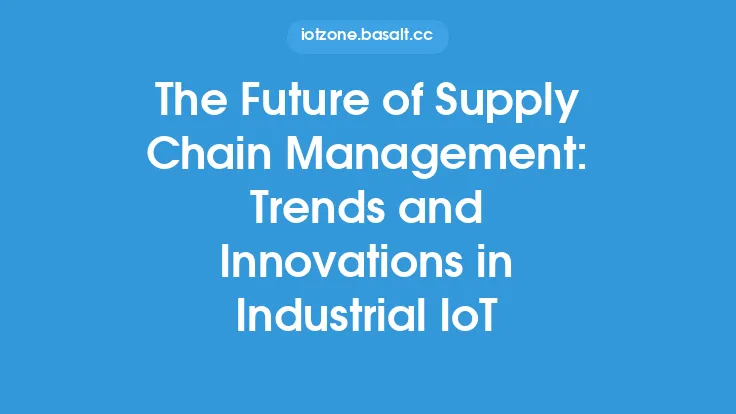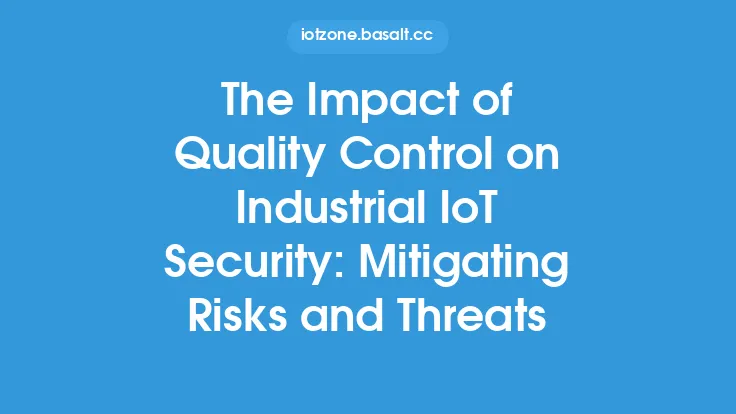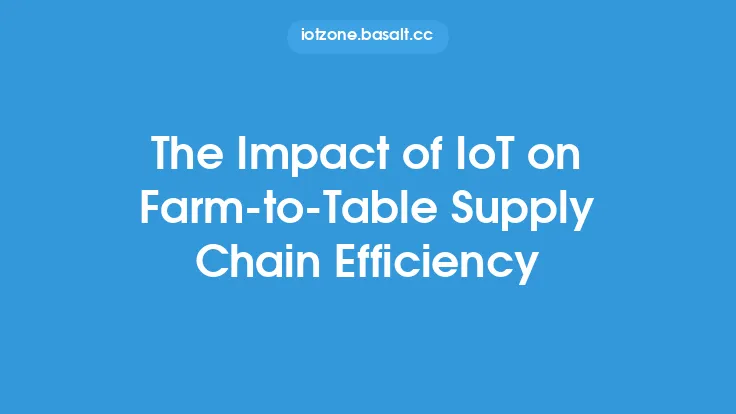The increasing complexity and interconnectedness of modern supply chains have made them more vulnerable to various types of risks, including disruptions, cyber threats, and data breaches. The Internet of Things (IoT) has emerged as a key technology in mitigating these risks and improving supply chain resilience. By leveraging IoT devices and sensors, organizations can gain real-time visibility into their supply chain operations, enabling them to identify potential risks and take proactive measures to mitigate them.
Introduction to Supply Chain Risk Management
Supply chain risk management (SCRM) is a critical component of modern supply chain management. It involves identifying, assessing, and mitigating potential risks that could disrupt the flow of goods, services, and information across the supply chain. Effective SCRM requires a deep understanding of the supply chain's complex dynamics, including the interactions between different stakeholders, processes, and systems. IoT technology has the potential to revolutionize SCRM by providing real-time data and insights that can help organizations anticipate and respond to potential risks.
IoT-Enabled Risk Identification and Assessment
IoT devices and sensors can be used to monitor various aspects of the supply chain, including inventory levels, shipment tracking, and equipment performance. This data can be used to identify potential risks, such as stockouts, delays, or equipment failures. Advanced analytics and machine learning algorithms can be applied to this data to assess the likelihood and potential impact of these risks, enabling organizations to prioritize their mitigation efforts. For example, IoT sensors can be used to monitor the temperature and humidity levels of perishable goods during transportation, enabling organizations to identify potential risks to product quality and take corrective action.
Real-Time Monitoring and Alert Systems
IoT-enabled real-time monitoring and alert systems can help organizations respond quickly to potential risks and disruptions. For example, IoT sensors can be used to monitor the location and status of shipments in real-time, enabling organizations to detect potential delays or diversions. Automated alert systems can be triggered when a potential risk is detected, enabling organizations to take proactive measures to mitigate its impact. This can include rerouting shipments, adjusting inventory levels, or notifying stakeholders of potential disruptions.
Predictive Maintenance and Quality Control
IoT technology can also be used to predict and prevent equipment failures, reducing the risk of disruptions to the supply chain. Predictive maintenance involves using IoT sensors and advanced analytics to monitor equipment performance and predict when maintenance is required. This can help organizations schedule maintenance during planned downtime, reducing the risk of unplanned disruptions. IoT technology can also be used to monitor product quality in real-time, enabling organizations to detect potential defects or anomalies and take corrective action.
Cybersecurity and Data Protection
The increasing use of IoT devices and sensors in supply chain operations has also introduced new cybersecurity risks. Organizations must ensure that their IoT systems are secure and that data is protected from unauthorized access or breaches. This can involve implementing robust security protocols, such as encryption and authentication, and ensuring that IoT devices are regularly updated and patched. Organizations must also ensure that they have the necessary skills and expertise to manage and secure their IoT systems, including data analytics and cybersecurity professionals.
Best Practices for Implementing IoT in SCRM
To realize the benefits of IoT in SCRM, organizations must follow best practices for implementing and managing IoT systems. This includes developing a clear strategy and roadmap for IoT adoption, ensuring that IoT systems are integrated with existing supply chain systems and processes, and providing training and support for employees. Organizations must also ensure that they have the necessary infrastructure and resources to support IoT adoption, including data storage and analytics capabilities. Finally, organizations must continuously monitor and evaluate the effectiveness of their IoT systems, making adjustments and improvements as needed.
Case Studies and Examples
Several organizations have successfully implemented IoT technology to improve their supply chain risk management capabilities. For example, a leading logistics company used IoT sensors and real-time monitoring to track the location and status of shipments, reducing the risk of delays and improving customer satisfaction. A major manufacturer used IoT technology to predict and prevent equipment failures, reducing downtime and improving overall equipment effectiveness. These case studies demonstrate the potential of IoT technology to improve supply chain resilience and reduce the risk of disruptions.
Conclusion
The Internet of Things (IoT) has the potential to revolutionize supply chain risk management by providing real-time visibility into supply chain operations and enabling organizations to identify and mitigate potential risks. By leveraging IoT devices and sensors, organizations can improve their ability to anticipate and respond to disruptions, reducing the risk of supply chain failures and improving overall resilience. As the use of IoT technology continues to grow and evolve, it is likely that we will see even more innovative applications of IoT in supply chain risk management, enabling organizations to build more agile, responsive, and resilient supply chains.




